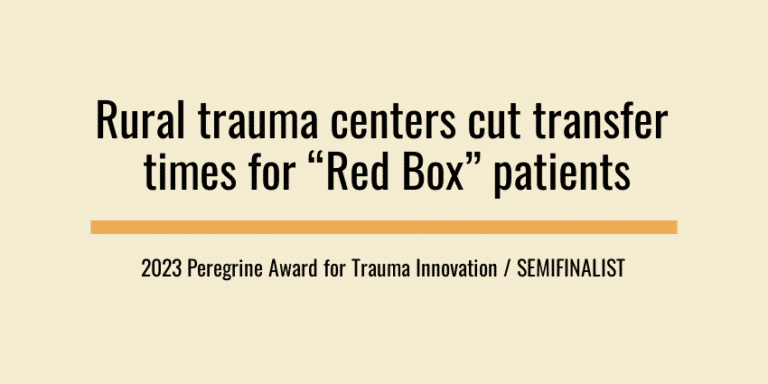
Mercy Medical Center Redding (Level II) and St. Elizabeth Community Hospital (Level III) serve eight counties in Northern California. With a catchment area of nearly 25,000 square miles of mountainous terrain, the hospitals face special obstacles to efficient trauma transfer. Trauma program managers Crystal Walsh, BSN (Mercy Redding) and Darcey Thinnes, BSN (St. Elizabeth) helped lead a system-wide effort to speed transfers for critically injured patients.
Challenge: Difficulty meeting 60-minute transfer goal
“The North Regional Trauma Coordinating Committee (NRTCC) developed regional guidelines for trauma transfers in 2002. ‘Red Box’ transfers (named after the criteria in a red box at the top of the guidelines document) are the highest priority, and every effort should be made to transfer these patients within 1 hour of arrival. However, many facilities were challenged in meeting the 60-minute goal for a variety of reasons. At St. Elizabeth, the average ED length of stay for Red Box patients was 122.2 minutes (more than double the goal). Through PI case review, we identified several root causes. Issues included lack of familiarity with Red Box criteria, time spent waiting for imaging studies, long transfer center acceptance processes and a lack of urgency at the bedside.”
Innovation: Streamlined algorithm, new form, education
“We collaborated with leaders throughout the system to decrease barriers to quick transfer for Red Box patients. Key changes included:
- Streamlining the transfer center algorithm (see below).
- Providing education to ED physicians, ED staff and EMS on Red Box criteria and processes.
- Creating a special form for Red Box transfers (and a tip sheet for using the form).
- Establishing processes for tracking and providing feedback within our PI process.
In addition, new data fields were added to the registry, allowing both the sending and the receiving facility to track Red Box transfers and create custom reports.
Results: Transfers under 1 hour for 99% of cases
“In the first 6 months, the average ED LOS for Red Box patients decreased from 122.2 minutes to 59.1 minutes. As part of this improvement, the average time from patient arrival at the referring facility to acceptance by the receiving facility decreased from 64.4 minutes to 18.2 minutes. The process was implemented in August 2022. By October 2022, we were able to meet the 60-minute goal for Red Box transfers in 99% of the cases.”
| Previous Algorithm | New Algorithm |
| 1. Call to Transfer Center from referring hospital 2. Transfer Center takes detailed information 3. Transfer Center calls nursing supervisor to see if there is a bed 4. If there is a bed, Transfer Center calls the ED for peer-to-peer and acceptance. 5. Peer-to-peer takes place. (May ask for more info and imaging.) 6. If accepted, referring facility calls for transport. |
1. Call to Transfer Center from referring hospital, explicitly stating “a Red Box transfer” (referring hospital simultaneously calls for transport). 2. Transfer Center takes minimal information. 3. Transfer Center calls ED for peer-to-peer. 4. All transfers accepted; no request for imaging that will delay transfer. |
This article was originally published in June 2023 in the 2023 Trauma Innovation Special Report.


